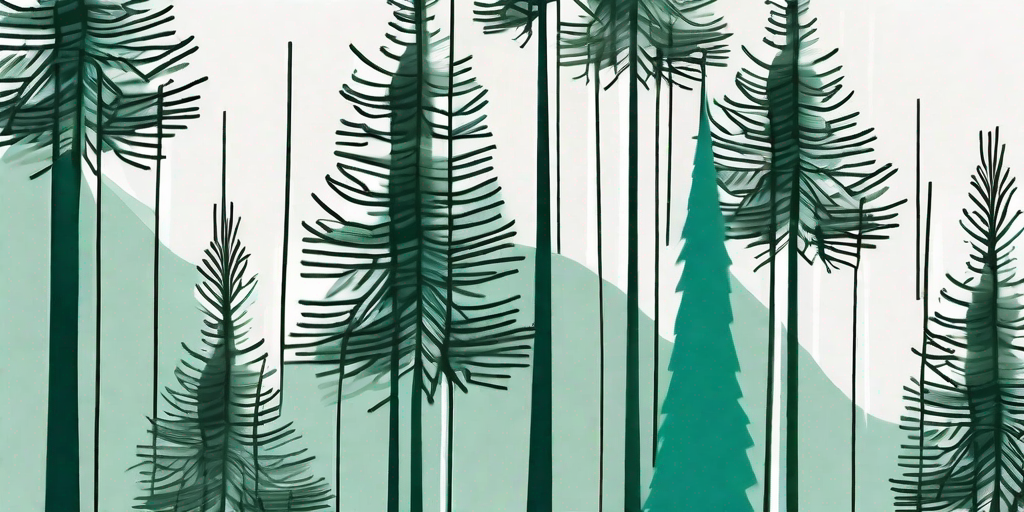
Welcome, dear reader, to the wonderful world of Larch trees. These fantastic specimens of nature are not just a treat for the eyes, but also hold a plethora of benefits that might just make you consider planting one in your backyard. So, buckle up and get ready for a journey through the larch landscape that's sure to be, well, larch-tastic!
A Brief Introduction to the Larch Tree
Before we dive into the thick of it, let's start with the basics. The larch tree, scientifically known as Larix, is a genus of deciduous conifers in the pine family. Yes, you read that right - a deciduous conifer. Sounds like an oxymoron, doesn't it? But that's one of the many quirks that make the larch tree so special.
While most conifers are evergreen, keeping their foliage all year round, the larch tree likes to shake things up a bit. It sheds its needles every autumn, standing bare throughout the winter, and then sprouts fresh, green needles come spring. It's the tree world's version of a wardrobe change, if you will.
The Larch Tree's Global Presence
Now, you might be wondering where these unique trees can be found. Well, the larch tree is quite the globetrotter. From the cold regions of Siberia and Canada to the mountainous areas of central Europe, the larch tree has made itself at home in various parts of the world. Each region has its own species of larch, with about 10 to 12 species in total.
So, whether you're hiking in the Alps or exploring the wilderness of Alaska, keep an eye out for these trees. Their distinctive conical shape and vibrant green needles are hard to miss, especially in the autumn when they turn a fiery gold before falling off.
The Many Benefits of the Larch Tree
Now that we've covered the basics, let's move on to the fun part - the benefits of the larch tree. And trust me, there are plenty.
Environmental Benefits
Like all trees, larches play a crucial role in our ecosystem. They absorb carbon dioxide, release oxygen, and provide habitat for various species of wildlife. But that's not all. Thanks to their deciduous nature, larch trees are also excellent at improving soil quality. When their needles fall off in the autumn, they decompose and enrich the soil with organic matter.
Moreover, larch trees are known for their hardiness. They can thrive in harsh climates and poor soil conditions where other trees might struggle. This makes them an excellent choice for reforestation projects and for stabilizing slopes and preventing soil erosion.
Economic Benefits
On the economic front, larch trees are a valuable resource for the timber industry. Larch wood is known for its strength and durability, making it a popular choice for construction, furniture, and even shipbuilding. Plus, it's resistant to rot, which is always a bonus when you're building something to last.
But the uses of larch don't stop at timber. The tree's bark and resin have been used in traditional medicine for centuries, and its seeds are a food source for many animals. So, whether you're a carpenter, a herbalist, or a squirrel, the larch tree has something for you.
FAQs about the Larch Tree
Now, let's address some of the most frequently asked questions about the larch tree.
- Are larch trees fast-growing?
Yes, larch trees are known for their rapid growth rate. They can grow up to 2 feet per year, reaching their full height of 50 to 100 feet in about 20 years.
- Can larch trees grow in my region?
Larch trees are quite adaptable and can grow in a variety of climates. However, they do best in cool, humid climates and well-drained soils. Check with your local nursery or extension service to see if larch trees are suitable for your area.
- Are larch trees evergreen?
No, larch trees are deciduous conifers. This means they shed their needles in the autumn and grow new ones in the spring.
Conclusion
So there you have it, folks - a comprehensive guide to the larch tree. From its unique deciduous nature to its environmental and economic benefits, this tree species truly is a marvel of the natural world.
Whether you're a tree enthusiast, an environmentalist, or just someone looking for a fun and informative read, I hope this article has given you a newfound appreciation for the larch tree. And who knows, maybe it's even inspired you to plant one in your backyard. After all, who wouldn't want a piece of this larch-tastic beauty?















